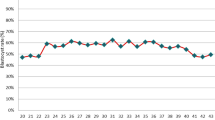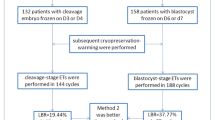Abstract
The widespread use of clomiphene citrate and exogenous gonadotrophins for in vitro fertilization (IVF) in humans1,2 frequently results in the production of multiple embryos. Replacement of more than two embryos increases pregnancy rate3 but may result in multiple pregnancies with increased pre- and post-natal abnormality. Preservation of embryos for a limited time allows fewer embryos to be replaced on several different occasions and thus the problems of multiple pregnancy can be minimized, the effectiveness of a single IVF procedure increased and embryo replacement in adverse maternal conditions avoided. Preimplantation embryos have been successfully cryopreserved in many animal species. The sensitivity of embryos to cooling and freezing varies between species and stages of embryo development4–6. We report here the cryopreservation procedures that allow a high survival rate of four- and eight-cell human embryos and the establishment of a pregnancy following the freezing and storage of an eight-cell embryo for 4 months in liquid nitrogen. The pregnancy terminated at 24 weeks' gestation due to development of a septic Streptomyces agalactiae chorion amnionitis after premature membrane rupture.
This is a preview of subscription content, access via your institution
Access options
Subscribe to this journal
Receive 51 print issues and online access
$199.00 per year
only $3.90 per issue
Buy this article
- Purchase on Springer Link
- Instant access to full article PDF
Prices may be subject to local taxes which are calculated during checkout
Similar content being viewed by others
References
Trounson, A. O., Leeton, J. F., Wood, C., Webb, J. & Wood, J. Science 212, 681–682 (1981).
Trounson, A. O. & Conti, A. Br. med. J. 285, 244–248 (1982).
Trounson, A. O., Mohr, L. R., Wood, C. & Leeton, J. F. J. Reprod. Fert. 64, 285–294 (1982).
Trounson, A. O., Shea, B. F., Ollis, G. W. & Jacobson, M. E. J. anim. Sci. 47, 667–681 (1978).
Mohr, L. R. & Trounson, A. O. Biol. Reprod. 25, 1009–1025 (1981).
Whittingham, D. G. J. Reprod. Fert. 49, 89–94 (1977).
Mohr, L. R. thesis, Monash Univ. (1983).
Willadsen, S. M. Nature 277, 298–300 (1979).
Willadsen, S. M. J. Embryol. exp. Morph. 65, 165–172 (1981).
Ciba Foundation The Freezing of Mammalian Embryos (Excerpta Medica, Amsterdam, 1977).
Trounson, A. O., Wood, C. & Leeton, J. F. Med. J. Aust. 2, 332–334 (1982).
Whittingham, D. G. Nature 233, 125–126 (1971).
Trounson, A. O. in Current Topics in Experimental Endocrinology Vol. 5, (eds Martini, V. & James, J.) 44–73 (Academic, London, 1983).
Wood, C., Leeton, J. F., Talbot, J. Mc. & Trounson, A. O. Br. J. Obstet. Gynaecol. 88, 756–760 (1981).
Leeton, J., Trounson, A. O., Jessup, D. & Wood, C. Fert. Steril. 38, 156–161 (1982).
Author information
Authors and Affiliations
Rights and permissions
About this article
Cite this article
Trounson, A., Mohr, L. Human pregnancy following cryopreservation, thawing and transfer of an eight-cell embryo. Nature 305, 707–709 (1983). https://doi.org/10.1038/305707a0
Received:
Accepted:
Issue Date:
DOI: https://doi.org/10.1038/305707a0
This article is cited by
-
Archiving the work of Dr. Subhas Mukherjee: The architect of India’s test tube baby
Indian Journal of History of Science (2024)
-
Clinical pregnancy rate for frozen embryo transfer with HRT: a randomized controlled pilot study comparing 1 week versus 2 weeks of oestradiol priming
Reproductive Biology and Endocrinology (2023)
-
Preparation of the endometrium for frozen embryo transfer: an update on clinical practices
Reproductive Biology and Endocrinology (2023)
-
Sir Ian Wilmut 1944–2023
Nature Biotechnology (2023)
-
Patient- and cycle-specific factors affecting the outcome of frozen–thawed embryo transfers
Archives of Gynecology and Obstetrics (2023)
Comments
By submitting a comment you agree to abide by our Terms and Community Guidelines. If you find something abusive or that does not comply with our terms or guidelines please flag it as inappropriate.



